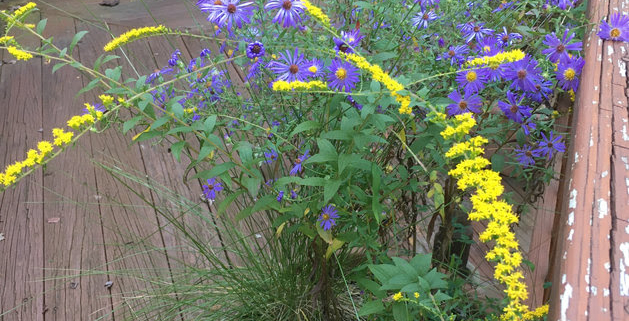Planting in Pots for Easy Butterfly Viewing
Photo and article by Plant NOVA Natives
Some of us are deeply into gardening, but the rest of us are content with plopping a few flowers into a pot and calling it a day. This explains a lot of the popularity of annuals, most of which end up in containers and are switched out when they fade. Their colors brighten up our decks and balconies all summer, but their value in most cases is only visual. Native perennial flowers, by contrast, not only look beautiful but actually support butterflies and other life.
Most plants that are native to our area will overwinter in a pot, thus saving us the trouble of replanting year after year. Although none of them will bloom for the entire growing season, they provide interest as they develop. It is easy to get continuous color by planting several species that bloom at different times.
Once blooming begins, the parade of associated pollinators is fascinating. Being able to view the flowers up close on a deck or balcony reveals the variety of critters that you might not notice from afar, from tiny metallic-blue bees to the whole range of butterflies. There are four hundred species of native bees in Virginia, none of which will sting you as they forage for food. Butterflies range in size from the tiny Least Skipper to the classic Eastern Tiger Swallowtail. With luck, you may even see a Monarch Butterfly, especially if you plant any of a number of the several local milkweed species. The milkweed Butterfly Weed (Asclepias tuberosa) is particularly ornamental and just the right size for container gardening. Just as Monarch caterpillars require milkweed to survive, every other butterfly has its preferred host plant with which it evolved. This is why adopting locally native plants is so important. The annuals sold in garden centers are not native and thus do not help butterflies complete their life cycles.
Birds also enjoy native plants in containers, as much as they would if planted in a garden. The seeds of Black-eyed Susan and other Rudbeckias are particularly popular with goldfinches. Of course, you will only see them if you allow the seed heads to remain. The shapes and colors of the dead stalks of native plants add a lot of interest to an otherwise barren deck in winter. You can also draw in hummingbirds when you use the red-flowered plants such as Cardinal Flower (Lobelia cardinalis) that they prefer.
Shade is no obstacle to container gardening with native plants. Particularly pleasing is the native Bleeding Heart (Dicentra eximia). The lacy, slightly bluish foliage is beautiful by itself, and blooms keep coming from April to the first frost.
You can learn all about container gardening with native plants on the Plant NOVA Natives website. The soil used in containers is designed to have good drainage, which means you can start planting earlier in the spring than in the rest of the garden, where working the wet soil would lead to harmful compaction.




